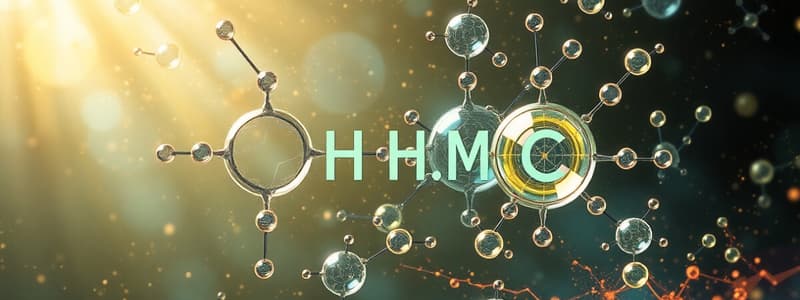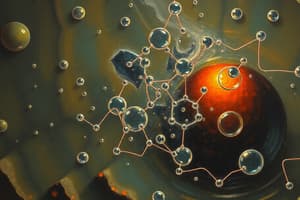Podcast
Questions and Answers
An atom's atomic number is determined by the:
An atom's atomic number is determined by the:
- Number of electrons orbiting the nucleus.
- Number of neutrons in the nucleus.
- Number of protons and neutrons in the nucleus.
- Number of protons in the nucleus. (correct)
In an electrically neutral atom, which statement accurately describes the relationship between protons and electrons?
In an electrically neutral atom, which statement accurately describes the relationship between protons and electrons?
- There are more protons than electrons.
- There are more electrons than protons.
- The number of neutrons equals the number of electrons.
- The number of protons equals the number of electrons. (correct)
Which of the following describes the organization of electrons within an atom?
Which of the following describes the organization of electrons within an atom?
- Electrons are randomly scattered within the nucleus.
- Electrons are concentrated in the center of the nucleus.
- Electrons are evenly distributed throughout the atom.
- Electrons are arranged in specific energy levels or shells around the nucleus. (correct)
What primarily determines whether atoms will form chemical bonds?
What primarily determines whether atoms will form chemical bonds?
In ionic bonding, what is the primary mechanism by which atoms achieve a stable electron configuration?
In ionic bonding, what is the primary mechanism by which atoms achieve a stable electron configuration?
Why do ionic compounds dissociate easily in water?
Why do ionic compounds dissociate easily in water?
Which characteristic is most associated with covalent bonds?
Which characteristic is most associated with covalent bonds?
What role do hydrogen bonds play in biological systems?
What role do hydrogen bonds play in biological systems?
How does dehydration synthesis contribute to the formation of larger molecules?
How does dehydration synthesis contribute to the formation of larger molecules?
What role does water play in hydrolysis reactions?
What role does water play in hydrolysis reactions?
If a solution has a pH of 3, what can you infer about the relative concentration of H+ ions?
If a solution has a pH of 3, what can you infer about the relative concentration of H+ ions?
What happens during the neutralization of a strong acid by a strong base?
What happens during the neutralization of a strong acid by a strong base?
Which of the following is a primary function of carbohydrates in the body?
Which of the following is a primary function of carbohydrates in the body?
How do phospholipids contribute to the structure of cell membranes?
How do phospholipids contribute to the structure of cell membranes?
What role does cholesterol play within cell membranes?
What role does cholesterol play within cell membranes?
Which of the following elements is found in proteins but not typically in carbohydrates or lipids?
Which of the following elements is found in proteins but not typically in carbohydrates or lipids?
What determines the specific function of a protein?
What determines the specific function of a protein?
How do enzymes affect chemical reactions?
How do enzymes affect chemical reactions?
What are the basic building blocks of nucleic acids?
What are the basic building blocks of nucleic acids?
What is a key structural difference between DNA and RNA?
What is a key structural difference between DNA and RNA?
Flashcards
Atom
Atom
The functional unit of matter, consisting of a central nucleus surrounded by outer 'orbitals'.
Nucleus
Nucleus
The central core of an atom, composed of protons and neutrons.
Proton
Proton
Positively charged particle located in the nucleus of an atom.
Neutron
Neutron
Signup and view all the flashcards
Atomic Number
Atomic Number
Signup and view all the flashcards
Atomic Mass
Atomic Mass
Signup and view all the flashcards
Orbitals
Orbitals
Signup and view all the flashcards
Element
Element
Signup and view all the flashcards
Molecule
Molecule
Signup and view all the flashcards
Compound
Compound
Signup and view all the flashcards
Electrolyte
Electrolyte
Signup and view all the flashcards
Covalent Bonds
Covalent Bonds
Signup and view all the flashcards
Hydrogen Bonds
Hydrogen Bonds
Signup and view all the flashcards
Acid
Acid
Signup and view all the flashcards
Base
Base
Signup and view all the flashcards
pH
pH
Signup and view all the flashcards
Neutralization
Neutralization
Signup and view all the flashcards
Carbohydrates
Carbohydrates
Signup and view all the flashcards
Lipids
Lipids
Signup and view all the flashcards
Proteins
Proteins
Signup and view all the flashcards
Study Notes
Levels of Chemical Organization
- The body's matter is classified into organization levels.
- Atoms are functional units with a central nucleus surrounded by orbitals.
- The nucleus is the atom's central core, composed of protons and neutrons.
- Protons are positively charged particles in the nucleus.
- Neutrons are non-charged particles in the nucleus.
- The atomic number is the number of protons in the nucleus.
- The atomic mass is the number of protons and neutrons in the nucleus.
- An electrically neutral atom has one electron (-) for every proton (+).
- Orbitals surround the atomic nucleus.
- Orbitals are arranged into energy levels based on distance from the nucleus.
- Energy increases with distance from the nucleus.
- An element is a pure substance made of only one kind of atom, like pure gold.
- A molecule is a group of atoms bound together, such as H₂O.
- A compound is a substance whose molecules have more than one kind of atom, such as CO₂ or NaCl.
Chemical Bonding
- Atoms form bonds to become more stable, which occurs when the outer energy level is full.
- Bonding happens by sharing, donating, or borrowing electrons.
- There are two types of bonds: ionic and covalent.
Ionic Bonds
- Ionic bonds form between atoms with one or two electrons in the outermost level that would hold eight, and an atom only needs one or two electrons to fill its outer level.
- The atom that has one or two 'donates' its outer shell to the one that only needs one or two.
- Ionic bonds easily break/dissolve in water.
- An electrolyte is a molecule that dissociates in water to form individual ions.
Covalent Bonds
- Covalent bonds form when atoms fill their energy levels by sharing electrons instead of donating or receiving them.
- Covalent bonds are not easily broken and do not easily dissociate in water.
Hydrogen Bonds
- Hydrogen bonds provide subtle forces that help keep larger molecules in a certain configuration, such as water (H₂O).
Inorganic Chemistry
- Living organisms contain organic and inorganic compounds.
- Organic compounds contain carbon-carbon and/or carbon-hydrogen covalent bonds.
- Inorganic compounds do not contain carbon-carbon or carbon-hydrogen bonds.
- Water, acids, bases, and salts are examples of inorganic molecules.
- Water is a solvent found in every cell and is involved in chemical reactions:
- Dehydration synthesis removes water from small molecules to form a larger molecule.
- Hydrolysis adds water to subunits of a large molecule to break it apart into smaller molecules.
- Chemical reactions involve energy transfers, storing it in chemical bonds and releasing it when bonds break.
- Chemical equations illustrate reactants interacting to form products, with arrows separating them and indicating the reaction's direction.
Acids, Bases and Salts
- Acid shifts the H⁺/OH⁻ balance in favor of H⁺, which is the opposite of a base.
- Base shifts the H⁺/OH⁻ balance against H⁺;It is an alkaline and the opposite of an acid.
- pH expresses H⁺ concentration.
- A pH of 7 is neutral and is the pH of pure water.
- Bases have a pH > 7
- Acids have a pH < 7
- Neutralization occurs when strong acids and strong bases mix and form salts and water.
- Strong acids completely/almost completely dissociate and create an excess of H⁺ ions.
- Strong bases completely/almost completely dissociate and create an excess of OH⁻ ions.
- Excess H⁺ ions may combine with excess OH⁻ ions to form water, neutralizing each other.
- pH homeostasis can be maintained through eliminating excess H⁺ ions via urine, increasing CO₂ loss via the respiratory system, and 'buffers' in the blood.
Organic Chemistry
- The four major organic compound types found in the body are:
- Carbohydrates
- Lipids
- Proteins
- Nucleic Acids
Carbohydrates
- Carbo means “sugar" and Hydrates (hydro) means water.
- Carbohydrates contain carbon (C), hydrogen (H), and oxygen (O).
- Carbohydrates are sugars and complex carbohydrates made up of six-carbon subunits called monosaccharides.
- Types of Carbohydrates: Monosaccharide, Disaccharide, and Polysaccharide.
- Carbohydrates provide the body with energy.
Lipids
- Lipids are fats and oils.
- Types of Lipids: triglycerides, phospholipids, and cholesterol.
- Triglycerides contain one glycerol unit and three fatty acids; bonds store energy.
- Phospholipids have one glycerol unit, two fatty acids, and one phosphorus-containing group, forming a hydrophilic head and a hydrophobic tail that creates stable double layers (bilayer) important for cell membranes.
- Cholesterol has a complex structure, combines with phospholipids in the cell membrane to stabilize structure, and is a precursor to steroid hormones.
Proteins
- Proteins are large molecules containing C, H, O and N.
- The basic protein units are amino acids that are held together in long chains by 'peptide bonds'.
- Forces along the chain cause folding and coiling into a complex 3-D shape.
- The structure/shape usually determines function.
Structural and Functional Proteins
:
- Structural proteins’ shape allows them to form structures of the body:
- Examples include collagen and keratin.
- Functional Proteins’ shape allows them to participate in reactions in the body.
- Examples include enzymes, growth factors, and hormones.
- Enzymes are chemical catalysts and reactions in the body depend on enzymes.
- Enzymes are not part of the reactants or the final product and are unchanged by the reaction.
- An enzyme's shape determines what reactions they are involved in ('shape-dependent' function = lock-and-key model).
Nucleic Acids
- Nucleic acids are an important component of the body's genetic material, DNA (deoxyribonucleic acid) and RNA (ribonucleic acid).
- The basic building blacks of nucleic acids are nucleotide units.
- Nucleotides contain a phosphate unit, sugar, and nitrogen base: adenine (A), thymine (T) or uracil (U), guanine (G), cytosine (C).
- DNA (deoxyribonucleic acid) is the cell's "master code” for assembling proteins.
- The DNA sugar is deoxyribose.
- The DNA nitrogen bases are A, T, C, and G.
- DNA has a double helix shape.
- RNA (ribonucleic acid) is a temporary “working copy” of a gene.
- The RNA sugar is ribose.
- The RNA bases are A, U, C, and G.
- RNA has a single strand shape.
Studying That Suits You
Use AI to generate personalized quizzes and flashcards to suit your learning preferences.




